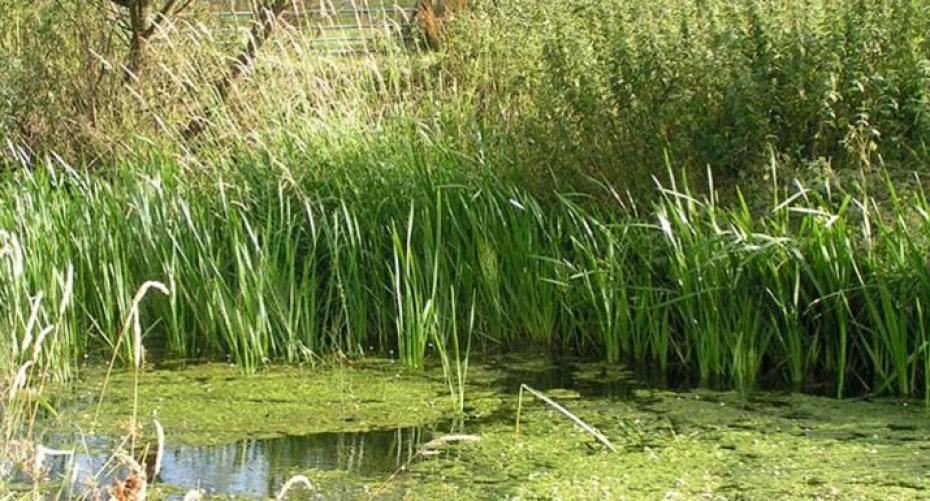A wildlife pond is attractive and an essential part of the garden ecosystem
Over 70% of our ponds in the countryside have been lost in the last century, so creating one in the garden is important for the survival of our insect and amphibian populations. A pond is an essential part of a wildlife garden. It must look in keeping with the rest of the area so some thought must be given to the surrounding planting. Surrounding planting could include a bog garden, a woodland area or a wildflower meadow. If you have young children you will have to either fence the area off or postpone it until they are older. Ponds attract a good range of wildlife. It is essential as a breeding site for insects and invertebrates. A large pond can attract wildfowl such as moorhens, coots and mallard ducks. Swallows and martins can scoop up the insects attracted to the water. If you want to attract insects and amphibians avoid putting fish in the pond as they will predate them.

Siting the pond
It needs to be situated away from overhanging trees as fallen leaves clog the pond and produce a layer of organic matter on the bottom. This layer eventually increases the nutrient value of the pond which produces excessive algal growth. A natural hollow would be a good site otherwise choose a level area. If you have a stream running through the garden this can be enlarged and dammed to form a natural pool. If however you want to plant water lilies the water must be still. It will need some sun falling onto the water surface so make sure it is not completely shaded.
How to make the pond
Mark out the area with sticks or garden hose. Take off the turves and dig out the pond to a minimum depth or 90cm (3’) with gently sloping sides, to allow any wildlife getting into the pond to escape. Keep the sides an even height. Remember that once the planting has matured the pond will look a lot smaller. Remove any sharp stones and cover with a layer of soft sand or old carpet. Place the butyl liner in the pond, trying to avoid folds and creases. A quick guide to measuring the butyl is: the length of the pond plus twice its maximum depth plus 10%, same formula for the width. Put a layer of the sieved soil taken from the hole and mixed with horticultural sand over the bottom of the pond. Don’t cut the butyl until it is filled with water. If possible fill with rainwater as it contains fewer chemicals than tap water. Cut the butyl and cover the edges with the turves or stones. Leave the pond to stand for two weeks to let any chemicals in the water evaporate before planting. An excess of butyl can be left around the edges to create a bog garden. Putting an area of cobbles or flat stones on one of the sloping sides will provide a refuge for the insects and amphibians.
You can buy pre-formed plastic ponds but they are difficult to get level and have too steep sides. They are also usually too small to attract much wildlife.
Planting
Oxygenators help keep the pond from stagnating and are usually available in garden centres tied in bunches with a lead weight to keep them on the bottom of the pond. Just throw them in and they will root into the silt on the bottom. If the pond is small avoid Potamogeton crispus (Curled Pondweed) as it is very vigorous and will quickly become invasive.
Aquatic plants root on the bottom of the pond and include Water Lilies which provide good shade. The pond needs to be 65 – 75% shaded, this helps avoid excessive algal growth, caused by too much sunlight, which will eventually clog the pond. Avoid the floating plants: Lemna (Duckweeds) and Azolla (Waterfern) as they are too invasive for a small pond.
Marginal plants grow in the shallow water on the edge of the pond and link the pond to the rest of the garden. You need a mixture of small creeping plants which cover the edge of the pond and provide cover for crawling insects and invertebrates. An intermediate layer will link the small plants to the taller reed-like plants. The taller plants are essential for Dragonfly naiads to crawl up before metamorphosing into an adult, and also provide cover for birds to escape predators. Avoid Iris pseudacorus (Yellow flag Iris), Glyceria maxima (Reed Sweet-grass), Phragmites communis (Common Reed) and Typha latifolia (Reedmace) as they all can quickly colonise a small pond.
Small shrubs can be planted around the dryer edges to give some shade and as a refuge for birds. Don’t plant trees as the roots will penetrate the butyl liner.
Maintenance
This is best carried out in the autumn. Pull out any excessive algal growth with a rake or a bunch of twigs. Leave it on the side of the pond for a few hours to allow any amphibians or insects to crawl back into the pond. Divide any marginal plants every 3 to 4 years. Plant up in aquatic baskets with aquatic compost. Don’t use ordinary compost as it contains too many nutrients which will cause algal growth. Algal growth can be controlled by making sure the pond is shaded and by putting in bales of barley straw.


